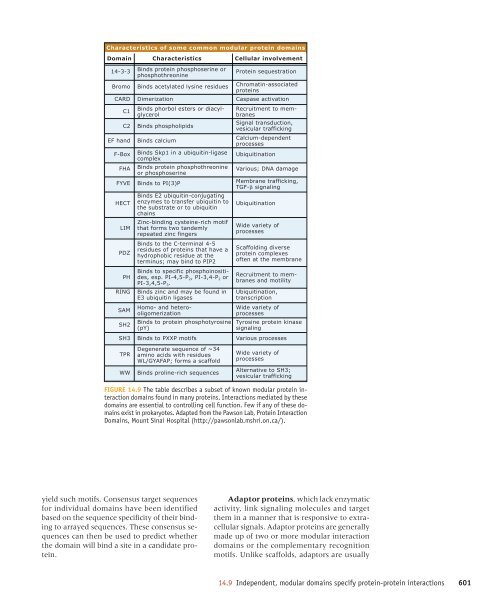Principles of cell signaling - UT Southwestern
Principles of cell signaling - UT Southwestern
Principles of cell signaling - UT Southwestern
Create successful ePaper yourself
Turn your PDF publications into a flip-book with our unique Google optimized e-Paper software.
39057_ch14_<strong>cell</strong>bio.qxd 8/28/06 5:11 PM Page 601<br />
Characteristics <strong>of</strong> some common modular protein domains<br />
Domain Characteristics Cellular involvement<br />
14-3-3 Binds protein phosphoserine or<br />
phosphothreonine<br />
Bromo<br />
CARD<br />
C1<br />
C2<br />
EF hand<br />
F-Box<br />
FHA<br />
HECT<br />
LIM<br />
PDZ<br />
PH<br />
RING<br />
SAM<br />
SH2<br />
Binds acetylated lysine residues<br />
Dimerization<br />
Binds phorbol esters or diacylglycerol<br />
Binds phospholipids<br />
Binds calcium<br />
Binds Skp1 in a ubiquitin-ligase<br />
complex<br />
Binds protein phosphothreonine<br />
or phosphoserine<br />
Binds E2 ubiquitin-conjugating<br />
enzymes to transfer ubiquitin to<br />
the substrate or to ubiquitin<br />
chains<br />
Zinc-binding cysteine-rich motif<br />
that forms two tandemly<br />
repeated zinc fingers<br />
Binds to the C-terminal 4-5<br />
residues <strong>of</strong> proteins that have a<br />
hydrophobic residue at the<br />
terminus; may bind to PIP2<br />
Binds to specific phosphoinositides,<br />
esp. PI-4,5-P 2 , PI-3,4-P 2 or<br />
PI-3,4,5-P 3 .<br />
Binds zinc and may be found in<br />
E3 ubiquitin ligases<br />
Homo- and heterooligomerization<br />
Binds to protein phosphotyrosine<br />
(pY)<br />
Protein sequestration<br />
Chromatin-associated<br />
proteins<br />
Caspase activation<br />
Recruitment to membranes<br />
Signal transduction,<br />
vesicular trafficking<br />
Calcium-dependent<br />
processes<br />
Ubiquitination<br />
Various; DNA damage<br />
FYVE Binds to PI(3)P Membrane trafficking,<br />
TGF- <strong>signaling</strong><br />
Ubiquitination<br />
Wide variety <strong>of</strong><br />
processes<br />
Scaffolding diverse<br />
protein complexes<br />
<strong>of</strong>ten at the membrane<br />
Recruitment to membranes<br />
and motility<br />
Ubiquitination,<br />
transcription<br />
Wide variety <strong>of</strong><br />
processes<br />
Tyrosine protein kinase<br />
<strong>signaling</strong><br />
SH3 Binds to PXXP motifs Various processes<br />
TPR<br />
WW<br />
Degenerate sequence <strong>of</strong> ~34<br />
amino acids with residues<br />
WL/GYAFAP; forms a scaffold<br />
Binds proline-rich sequences<br />
Wide variety <strong>of</strong><br />
processes<br />
Alternative to SH3;<br />
vesicular trafficking<br />
FIGURE 14.9 The table describes a subset <strong>of</strong> known modular protein interaction<br />
domains found in many proteins. Interactions mediated by these<br />
domains are essential to controlling <strong>cell</strong> function. Few if any <strong>of</strong> these domains<br />
exist in prokaryotes. Adapted from the Pawson Lab, Protein Interaction<br />
Domains, Mount Sinai Hospital (http://pawsonlab.mshri.on.ca/).<br />
yield such motifs. Consensus target sequences<br />
for individual domains have been identified<br />
based on the sequence specificity <strong>of</strong> their binding<br />
to arrayed sequences. These consensus sequences<br />
can then be used to predict whether<br />
the domain will bind a site in a candidate protein.<br />
Adaptor proteins, which lack enzymatic<br />
activity, link <strong>signaling</strong> molecules and target<br />
them in a manner that is responsive to extra<strong>cell</strong>ular<br />
signals. Adaptor proteins are generally<br />
made up <strong>of</strong> two or more modular interaction<br />
domains or the complementary recognition<br />
motifs. Unlike scaffolds, adaptors are usually<br />
14.9 Independent, modular domains specify protein-protein interactions 601
















